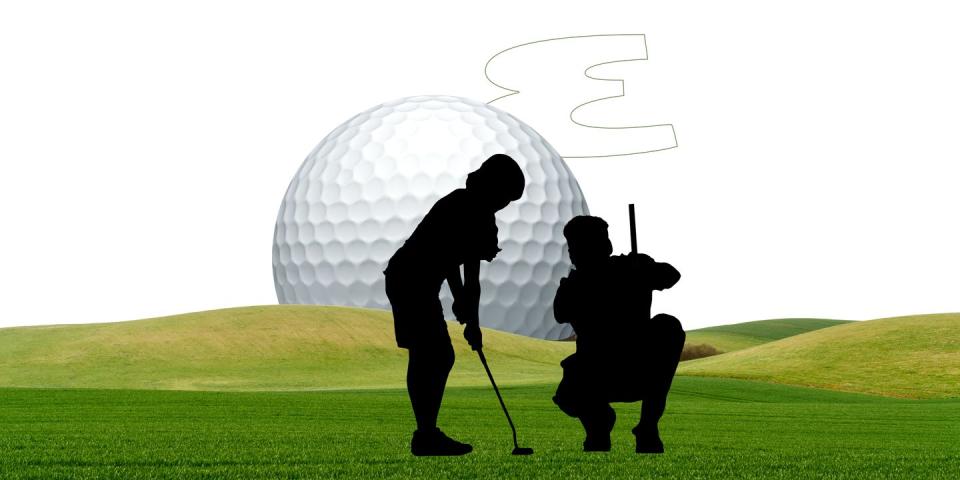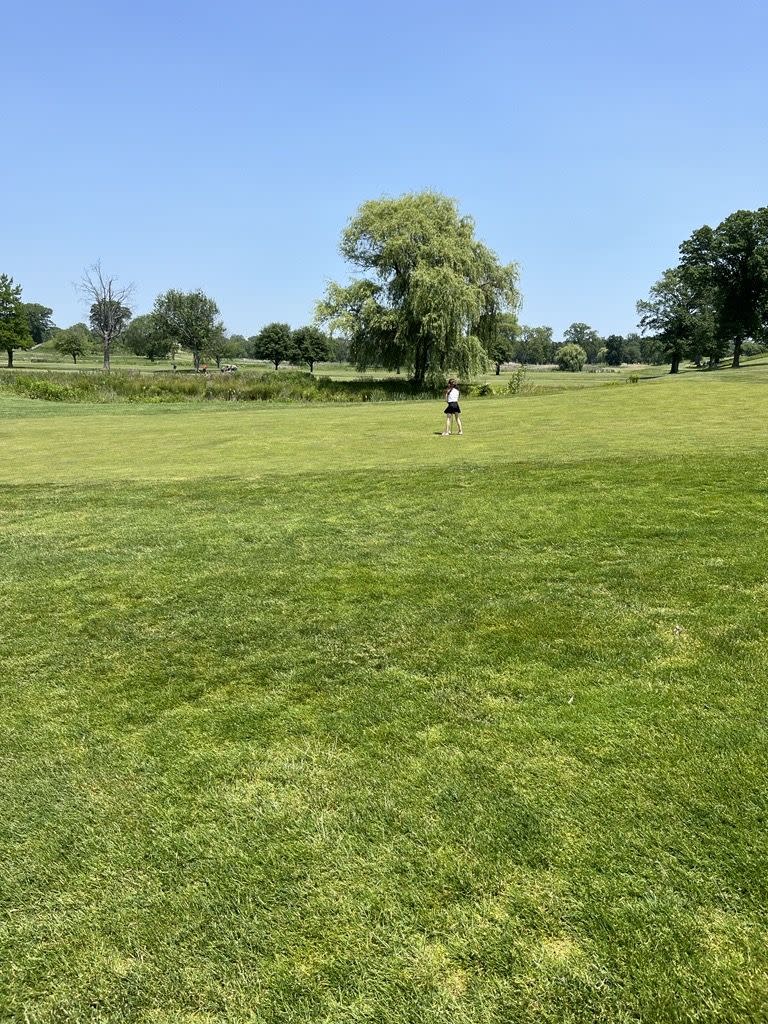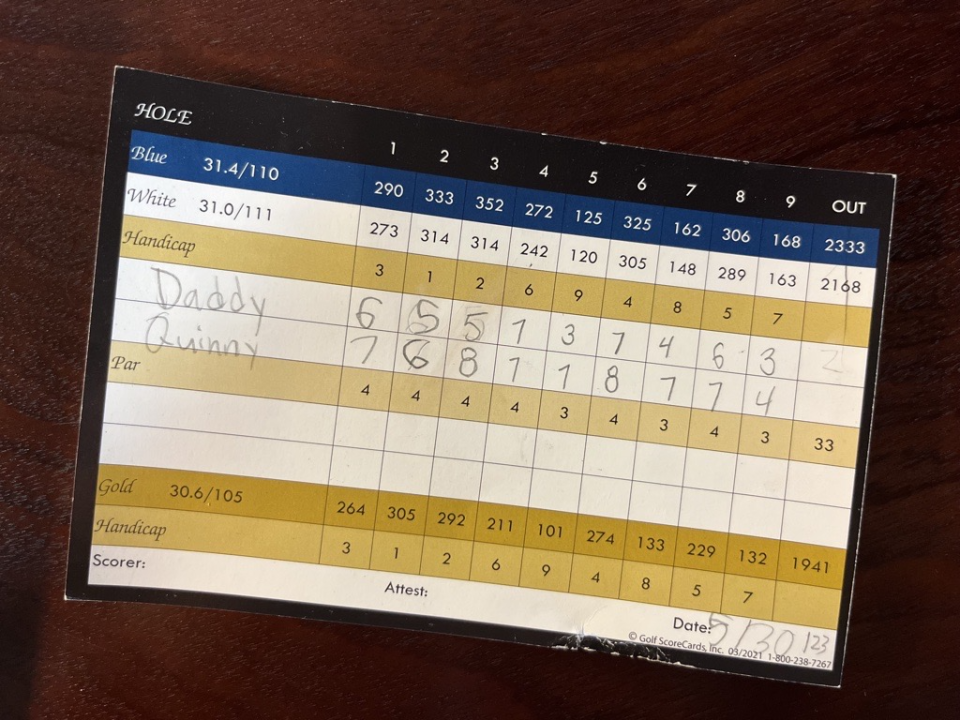The Day My Daughter Learned the Hip Drill

The fourth hole at Galloping Hill Golf Course’s “Learning Nine” is a quirky, amalgamated par-4. Straight away, the green makes a little left-hand turn—nothing the casual weekend duffer can’t handle. It’s just 272 yards, which is the golf equivalent of lowering the basketball hoop to eight feet so you can dunk the hell out of it. It’s wedged in the back corner of the property, away from most of play. A perfect place for a quiet moment.
Which is exactly why the fourth hole at Galloping Hill Golf Course’s “Learning Nine” is the last place on Earth I would have envisioned turning into my father.
My daughter Quinn is about 20 yards in front of the golf cart I am sitting in. She is eight years old, playing the first round of golf in her life, and the fact that we have made it to the fourth hole would’ve been enough of a victory to count the day as a win. But Quinn is also now very into it, which means that I am obliged to break the cardinal rule of golf: Giving a lesson on the course.
“Daddy, do I stand like this?”
I know exactly which chapter to go to in The Bob Prunty Book of Golf Tips: the hip drill.
“OK, OK, stop right there,” I say, sliding out of the golf cart. “I want you to do something first.”
She turns and squints puzzlingly, waiting for me to dole out this magical piece of advice. I tell her to take her blue 8-iron, the one we bought at Dick’s for $19.99, and hold it up to her hips with the club head pointing out toward the flag on the green.

“Where’s the club pointing to?” I ask.
She points to the bunker in front of the green.
“But, where do I stand?” she asks.
I move behind Quinn, hold the club up against her hips, and rotate her toward the flag.
“Your hips should always be in line with your target,” I say.
She steadies herself over the ball, takes her right pointer finger and draws a line in the air where she wants to hit the ball. (This is not in The Bob Prunty Book of Golf Tips. It appears we will need to make an addendum.)
“Now, swing.”
Quinn's orange ball flew in the air about 30 yards, perfectly in the direction of the green where she had been aiming. She spun around, those perfect curls bouncing off of her shoulders, with a smile so genuine you cannot help but return its favor. She shoves a pointed finger in the direction of the ball.
“Ah!” she says, starting to giggle. “It did exactly what you said it would!”
I smile and nod.
“How did you know to do that? Did your dad teach you?”
Now, there was a question that stopped me in my tracks.
Here’s the thing to know about my dad, Bob. In that moment, in the warm sun of a late spring afternoon, no one would’ve been prouder of a single golf shot in the recorded history of the sport, than he would’ve been. Not that I remembered to use something he had shown me as a kid some 30 years before. (Though, in his Brooklyn accent, he would have given me an unyielding amount of grief.) Or that it actually worked.
It's that this stupid hip drill gave the granddaughter he never got to meet, a tangible connection with her dad.
When you are a parent, you worry about the big things: the emotions, the experiences, the moments big and small. You worry if you’re giving them the right advice. Help them make the right friends. Do the right things. Become the right person. These days, it seems there is a class or a book or an Instagram model or a Substack everywhere you turn providing tips and tricks on how to be the best parent. How to help them be the people you want them to be.
I love my kids, but I will be the first to admit: I am often not the dad I want to be. I probably yell too much, or work too much, or am on my iPhone more than I should be. I worry about being present with them, sharing their experiences, remembering their moments. I worry if I have a stupid hip drill to pass down to them.
I wonder though: Was he like this? Did he have these worries? These fears? Would he have done things differently before the Alzheimer’s began its encroachment on his mind? Should I?
Do I want the one legacy after I’m gone to be a swing tip for golf?
Is that enough?
My dad has now been dead longer than he was alive with me. That’s the other thing they don’t tell you when you become a parent: that the memories of your own kids soon take the place of the ones you had with your parents. You begin to forget some of their mannerisms. When they did things for you. On occasion, I’ve started to realize I am forgetting what he sounded like.
The Alzheimer’s makes that even tougher, because the final lasting physical memories are the ones you want to throw away. How he argued with his own reflection. How he filled the leather briefcase with his initials “RPP” with sticks from our backyard instead of important papers. How he would ask you if you had seen his son, Brendan. And so, I missed out on all the big moments. The ones where your dad is supposed to be there to give you that piece of advice. That nugget of wisdom. That reassurance that you’re doing just fine.
Instead, I have… the hip drill.
But maybe that’s the point.

Golf was always the thing we bonded over. Even all these years later—and as I (gulp!) approach middle-age myself, those are the memories which are outlasting the physical, tangible ones of him. Him reclining on our gray sofa in the family room, dozing off to a run-of-the-mill PGA Tour event on a Saturday afternoon. Father’s Day being the one day of the year we were allowed to eat dinner in front of the TV, because it was the final round of the U.S. Open. Getting our picture taken before the father-son scramble at the club we belonged to. Him not letting me cheat my way to getting my yellow card, which would’ve allowed me to play by myself.
As I walked with Quinn to hit her next shot, I stood back and watched her stand over the ball, get ready to hit it, and then stop. She put the club up against her hips, pointed it to where she wanted to go, drew the line in the air with her finger, and then swung away. Once again, she hit a little blooper, this time up onto the green. Now, the smile was on my face.
I shook my head and laughed. Now the hip drill had officially been passed down to a third generation, which is when I realized the beauty in having that memory—with my dad, on a golf course—frozen in time. Preserved for a moment, like this very one. I have, out of instinct, used the hip drill for as long as I can remember. Used it when I played by myself during Mondays as a caddie in high school. When I skipped class to play 18 with my roommates in college. When I was fortunate to play some of the world’s best courses during my days as a full-time golf writer. When life allows you the rare opportunities to play 18 holes with fellow dads.
And now, with my own child.
After putting out, Quinn bounced around, running excitedly across the green, to the next tee box. All she could talk about was how she hit the ball straight and in the air. In the moment, I was simply happy she was having a great time, out of the house on a beautiful day, enjoying herself. But all she wanted to know was about was what I had showed her. The hip drill had actually worked, and she was curious for more.
All I could do was laugh and tell her I was glad it worked, because when my dad showed me, it always helped me.
She posed one more question.
“Did your dad teach you everything you know about golf?”
Almost.
You Might Also Like

 Yahoo Sports
Yahoo Sports 
